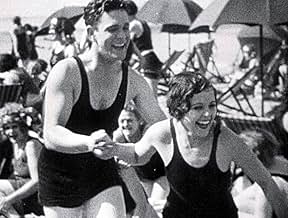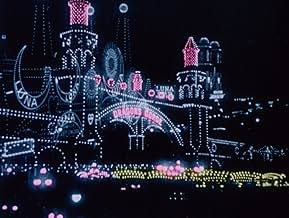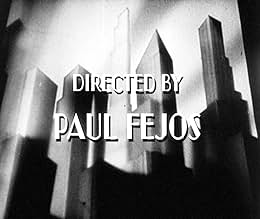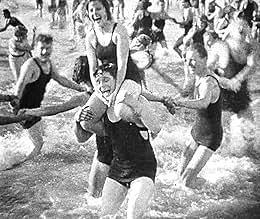VALUTAZIONE IMDb
7,7/10
2804
LA TUA VALUTAZIONE
Aggiungi una trama nella tua linguaTwo lonely people in the big city meet and enjoy the thrills of an amusement park, only to lose each other in the crowd after spending a great day together. Will they ever see each other aga... Leggi tuttoTwo lonely people in the big city meet and enjoy the thrills of an amusement park, only to lose each other in the crowd after spending a great day together. Will they ever see each other again?Two lonely people in the big city meet and enjoy the thrills of an amusement park, only to lose each other in the crowd after spending a great day together. Will they ever see each other again?
- Regia
- Sceneggiatura
- Star
- Premi
- 1 vittoria in totale
Gusztáv Pártos
- Romantic Gentleman
- (as Gustav Partos)
Henry Armetta
- Ferris wheel guy
- (non citato nei titoli originali)
Edgar Dearing
- Cop
- (non citato nei titoli originali)
Louise Emmons
- Telephone Caller
- (non citato nei titoli originali)
Fred Esmelton
- Swami
- (non citato nei titoli originali)
Jack Raymond
- Barker
- (non citato nei titoli originali)
Churchill Ross
- Telephone Caller
- (non citato nei titoli originali)
Recensioni in evidenza
8sb88
It's a shame Lonesome hasn't been seen more widely by modern audiences. The limited acclaim it's received is well deserved.
Lonesome is very simple. It's no more than a little romantic movie of two people who fall in love and then appear to lose each other. But the whole thing is told expertly well. The camera moves about freely in many unique and interesting ways. Visually alone, it's quite the spectacle. It also helps that the two in the lead roles are enjoyable.
Glenn Tyron is good enough in his lead role, but his romantic interest, played by Barbara Kent, is the real star. She is fun and playful when needed, but her soulful eyes convey more pain then most people ever could with their voices. Her charisma is evident from shot one.
The only downside to the film is the inclusion of a few sound scenes. Clearly done just to cash in on the new craze, it actually only serves to grind the story to a halt. It forces the movie to become stationary, and the dialogue itself is pretty inane.
I cannot recommend the film strongly enough, though. It's as enjoyable of a romance as you'll ever see. There's nothing too complicated here: just two people falling in love, and it's a joy to see.
Lonesome is very simple. It's no more than a little romantic movie of two people who fall in love and then appear to lose each other. But the whole thing is told expertly well. The camera moves about freely in many unique and interesting ways. Visually alone, it's quite the spectacle. It also helps that the two in the lead roles are enjoyable.
Glenn Tyron is good enough in his lead role, but his romantic interest, played by Barbara Kent, is the real star. She is fun and playful when needed, but her soulful eyes convey more pain then most people ever could with their voices. Her charisma is evident from shot one.
The only downside to the film is the inclusion of a few sound scenes. Clearly done just to cash in on the new craze, it actually only serves to grind the story to a halt. It forces the movie to become stationary, and the dialogue itself is pretty inane.
I cannot recommend the film strongly enough, though. It's as enjoyable of a romance as you'll ever see. There's nothing too complicated here: just two people falling in love, and it's a joy to see.
A sister of Sunrise and The Crowd, this film is more emotional and poetic than those landmarks and every bit as great. The plot concerns two working class American types, he works in the factory, she works on the intercom who meet by chance on a fairground and fall in love and then lose each other without knowing where the other lives.
The film's beginning is to be treasured, it follows in detail the morning ritual of first the girl and then the man in their respective homes. The effect conveyed is the organization and elegance of women over the tardy, rushed, half-baked activities of men. The love story between the two characters is so beautifully etched and played so naturalistically by the actors(Barbara Kent and Glenn Tryon) that the sense of loss in the latter half of the film is all the more painful and heart-breaking. The film deals with a certain truth about living in a city that has remained constant even after a good 80 years. At once a constant sense of community and at other an equally constant sense of loneliness from being in a crowd.
The film's beginning is to be treasured, it follows in detail the morning ritual of first the girl and then the man in their respective homes. The effect conveyed is the organization and elegance of women over the tardy, rushed, half-baked activities of men. The love story between the two characters is so beautifully etched and played so naturalistically by the actors(Barbara Kent and Glenn Tryon) that the sense of loss in the latter half of the film is all the more painful and heart-breaking. The film deals with a certain truth about living in a city that has remained constant even after a good 80 years. At once a constant sense of community and at other an equally constant sense of loneliness from being in a crowd.
10Varlaam
This film is outstanding.
A man and woman leave their respective rented rooms for work. He's a "punch presser"; she's a switchboard operator. After work, neither one feels up to joining friends; they just feel too ... single. But they both head to Coney Island. They meet, fall in love, get separated, return home distressed. A plot that simple, even clichéd, does not appear to hold much promise.
But the energy! The pacing is so frenetic. There's constant movement on camera, clocks ticking, crowds scurrying, throngs crushing, machines stamping, carnivals, streamers, roller coaster rides. Moments of relative calm come when the lovers are together.
The thrilling impersonality of the urban maelstrom has hardly been better depicted. I came away thinking it was one of the best things I've seen.
If you've seen "The Devil and Miss Jones", the Jean Arthur / Robert Cummings comedy from 1941, then you can't help but remember the Coney Island beach scene where everyone is packed in together with barely room to move.
Well, this film has a scene just like that one. In fact, the greater part of the film is that way. You're never so alone as when you're in a crowd. These scenes are funny, but they do make their point.
I saw a restored print of "Solitude" (as it was titled) with colour tinting and three sound sequences, courtesy of Cinematheque Ontario. The sound segments are just awful, so typical of the very earliest sound, but perhaps they're a blessing in disguise. The extraordinary quality of the silent film is spotlighted by the awkwardness of these three brief scenes: Jim and Mary on the beach, Jim and Mary near the midway, Jim at the police station.
The ultimate restoration of this elusive marvel would make the film silent throughout, liberating it from the stylistic cacophony of the stilted sound sequences.
Neither lead performer, Barbara Kent nor Glenn Tryon, was known to me previously. (Andy Devine is plainly recognizable however.) It seems that Tryon later became the producer of "Hellzapoppin" and "Hold That Ghost". He also holds the only acting credit for a film that anyone at all seems to have seen, "Variety Girl" from 1947. To me, Barbara Kent resembles Paulette Goddard somewhat, while Glenn Tryon looks like a brother to Don DeFore and Bob Cummings.
The screening I attended was the Toronto première of the restoration. Let's hope it now becomes more widely available.
A man and woman leave their respective rented rooms for work. He's a "punch presser"; she's a switchboard operator. After work, neither one feels up to joining friends; they just feel too ... single. But they both head to Coney Island. They meet, fall in love, get separated, return home distressed. A plot that simple, even clichéd, does not appear to hold much promise.
But the energy! The pacing is so frenetic. There's constant movement on camera, clocks ticking, crowds scurrying, throngs crushing, machines stamping, carnivals, streamers, roller coaster rides. Moments of relative calm come when the lovers are together.
The thrilling impersonality of the urban maelstrom has hardly been better depicted. I came away thinking it was one of the best things I've seen.
If you've seen "The Devil and Miss Jones", the Jean Arthur / Robert Cummings comedy from 1941, then you can't help but remember the Coney Island beach scene where everyone is packed in together with barely room to move.
Well, this film has a scene just like that one. In fact, the greater part of the film is that way. You're never so alone as when you're in a crowd. These scenes are funny, but they do make their point.
I saw a restored print of "Solitude" (as it was titled) with colour tinting and three sound sequences, courtesy of Cinematheque Ontario. The sound segments are just awful, so typical of the very earliest sound, but perhaps they're a blessing in disguise. The extraordinary quality of the silent film is spotlighted by the awkwardness of these three brief scenes: Jim and Mary on the beach, Jim and Mary near the midway, Jim at the police station.
The ultimate restoration of this elusive marvel would make the film silent throughout, liberating it from the stylistic cacophony of the stilted sound sequences.
Neither lead performer, Barbara Kent nor Glenn Tryon, was known to me previously. (Andy Devine is plainly recognizable however.) It seems that Tryon later became the producer of "Hellzapoppin" and "Hold That Ghost". He also holds the only acting credit for a film that anyone at all seems to have seen, "Variety Girl" from 1947. To me, Barbara Kent resembles Paulette Goddard somewhat, while Glenn Tryon looks like a brother to Don DeFore and Bob Cummings.
The screening I attended was the Toronto première of the restoration. Let's hope it now becomes more widely available.
10clanciai
The striking character of this film is its extreme intensity in a fantastic camera work that keeps rushing on in breathless frenzy to the very bitter end of the film. It's almost like a documentary in its constant flow of following the crowds from the working places to the reckless carneval of Coney Island, never leaving the strenuous hard pace of life for one second, except for the moments when the lovers find each other. Then there is a touch of poetry, which also marks the film with a totally different character, which makes it doubly interesting. This film is like no other film, the closest in likeness is actually Eisenstein's "Battleship Potemkin" which also wallows in following the crowds in wild frenzy, but here the lovers provide some privacy and individualism, which is totally missing in Eisenstein's masterpiece, and this is certainly a masterpiece of the same rank but on a different level, for its very human touch of simplicity and basic togetherness. There are also some resemblance to Fritz Lang's "Liliom" with Charles Boyer, which also renders the carneval and wild pleasure hunting in frenzied rush of popular festivity in unforgettable cinematography.
Paul Fejos made many documentaries, he was a master and genius in observing and capturing life at its most original and basic level, his documentaries are from Madagascar, South East Asia, Peru apart from Europe and America, he made altogether 44 films, and this is just an example of his extremely personal and highly advanced art of the film.
Paul Fejos made many documentaries, he was a master and genius in observing and capturing life at its most original and basic level, his documentaries are from Madagascar, South East Asia, Peru apart from Europe and America, he made altogether 44 films, and this is just an example of his extremely personal and highly advanced art of the film.
Even though I have been a silent film enthusiast for 50 years now (I started very young) and have read a number of books on the subject as well as having amassed a rather large collection of silent movies on DVD, I can't remember ever having run across the name of Hungarian born director Paul Fejos. I'm sure there must have been something but I simply can't recall it. After watching this Criterion release, it seems unbelievable that his Hollywood films could have been lost for as long as they were. Two of the three films are welcome additions to the silent film catalog while one is a curious early sound offering. All 3 films on this disc were made for Universal so it's only fitting that they reappear in time for the company's 100th anniversary.
The true prize of the collection is LONESOME, a 1929 film that recalls both SUNRISE and 7th HEAVEN in its storyline and in its cinematic expression of that story. Glenn Tryon (who I knew from some Hal Roach comedy shorts) and Barbara Kent (the sister in FLESH & THE DEVIL) play a pair of lonely blue collar workers who discover each other during a visit to Coney Island. They meet, fall in love, and then are separated by a massive rainstorm without knowing their last names. A simple enough story but it's what Fejos does with the material that makes LONESOME so remarkable. Technically this film goes far beyond SUNRISE in its camerawork and editing resulting in an eye opening cinematic experience that the director called a "Coney Island of the mind".
The other two films on an additional DVD make for an interesting evening. THE LAST PERFORMANCE stars Conrad Veidt as a jealous stage magician whose love for his young assistant (Mary Philbin in her best performance) leads to tragedy. Imagine one of the Tod Browning Lon Chaney films as if it had been directed by F. W. Murnau and that will give you some idea of what it's like. The print used here was found in Denmark and still has Danish title cards. While that proves the universality of silent movies, it would have been nice if new title cards could have been made. The film has also not been restored and is occasionally contrasty and shows some print damage. It's not ideal but is quite serviceable and Conrad Veidt is amazing.
BROADWAY was one of Universal's early sound extravaganzas. It not only features dialogue and musical numbers but it also has an early Technicolor finale. Unless you are really into early sound musicals, BROADWAY is more of historical interest. There are some truly remarkable camera shots courtesy of the "BROADWAY crane" which revolutionized camera movement. The influence on later musicals and Busby Berkeley is obvious. Unfortunately the dialog is incredibly stiff ("Where-is-Steve? He's-in-the-next-room.) and slows down the action. Glenn Tryon is on hand once again as the male lead and it's always great to see Evelyn Brent in anything. This is what THE ARTIST would have been like had it been made in 1929. While this release is an absolute must for silent movie fans others will find it to be of limited interest...For more reviews visit The Capsule Critic.
The true prize of the collection is LONESOME, a 1929 film that recalls both SUNRISE and 7th HEAVEN in its storyline and in its cinematic expression of that story. Glenn Tryon (who I knew from some Hal Roach comedy shorts) and Barbara Kent (the sister in FLESH & THE DEVIL) play a pair of lonely blue collar workers who discover each other during a visit to Coney Island. They meet, fall in love, and then are separated by a massive rainstorm without knowing their last names. A simple enough story but it's what Fejos does with the material that makes LONESOME so remarkable. Technically this film goes far beyond SUNRISE in its camerawork and editing resulting in an eye opening cinematic experience that the director called a "Coney Island of the mind".
The other two films on an additional DVD make for an interesting evening. THE LAST PERFORMANCE stars Conrad Veidt as a jealous stage magician whose love for his young assistant (Mary Philbin in her best performance) leads to tragedy. Imagine one of the Tod Browning Lon Chaney films as if it had been directed by F. W. Murnau and that will give you some idea of what it's like. The print used here was found in Denmark and still has Danish title cards. While that proves the universality of silent movies, it would have been nice if new title cards could have been made. The film has also not been restored and is occasionally contrasty and shows some print damage. It's not ideal but is quite serviceable and Conrad Veidt is amazing.
BROADWAY was one of Universal's early sound extravaganzas. It not only features dialogue and musical numbers but it also has an early Technicolor finale. Unless you are really into early sound musicals, BROADWAY is more of historical interest. There are some truly remarkable camera shots courtesy of the "BROADWAY crane" which revolutionized camera movement. The influence on later musicals and Busby Berkeley is obvious. Unfortunately the dialog is incredibly stiff ("Where-is-Steve? He's-in-the-next-room.) and slows down the action. Glenn Tryon is on hand once again as the male lead and it's always great to see Evelyn Brent in anything. This is what THE ARTIST would have been like had it been made in 1929. While this release is an absolute must for silent movie fans others will find it to be of limited interest...For more reviews visit The Capsule Critic.
Lo sapevi?
- QuizIt was one of the first motion pictures to have sound and a couple of talking scenes. It was released in both silent and monaural versions. Some scenes in existing original prints of the film are colored with stencils.
- Versioni alternativeProduced in both sound and silent versions. The sound version was 6,785 feet in length, and the silent version was 6,193 feet.
- ConnessioniFeatured in Fejezetek a film történetéböl: Az amerikai film kezdetei (1989)
- Colonne sonoreAlways
(uncredited)
Written by Irving Berlin
[Played by dance orchestra at ballroom]
Sung by Nick Lucas
[on Brunswick recording played in last scene]
I più visti
Accedi per valutare e creare un elenco di titoli salvati per ottenere consigli personalizzati
- How long is Lonesome?Powered by Alexa
Dettagli
- Tempo di esecuzione1 ora 9 minuti
- Mix di suoni
- Proporzioni
- 1.19:1
Contribuisci a questa pagina
Suggerisci una modifica o aggiungi i contenuti mancanti

Divario superiore
By what name was Primo amore (1928) officially released in India in English?
Rispondi





























